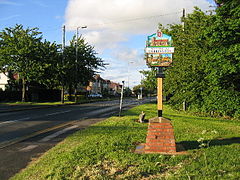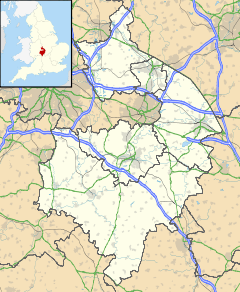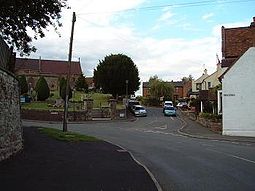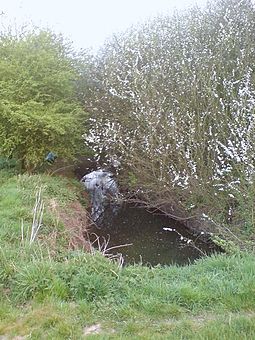- Cubbington
-
Coordinates: 52°18′43″N 1°29′53″W / 52.312°N 1.498°W
Cubbington 
Village sign on the boundary with New Cubbington at the top of Windmill Hill
 Cubbington shown within Warwickshire
Cubbington shown within WarwickshirePopulation 4,034 (2001 census)[1] OS grid reference SP3468 Parish Cubbington District Warwick Shire county Warwickshire Region West Midlands Country England Sovereign state United Kingdom Post town Leamington Spa Postcode district CV32 Dialling code 01926 Police Warwickshire Fire Warwickshire Ambulance West Midlands EU Parliament West Midlands UK Parliament Warwick and Leamington List of places: UK • England • Warwickshire Cubbington is a village and civil parish with a population of 4,034 (2001 census) adjoining the north-eastern outskirts of Royal Leamington Spa, Warwickshire, England. Welsh Road, running through the village crossroads, may have been an old sheep drovers' route connecting London and Wales.[citation needed] Since the 1950s when the village expanded there have been two parts to the village: Cubbington proper which was the old village core, and New Cubbington which is to the west, although both are referred to as Cubbington. Topographically the highest point of the village sits about 100 metres (330 ft) above sea level whilst its lowest is about 60 metres (200 ft). For many years the electorate for Cubbington was represented in government by the Member of Parliament for Warwick and Leamington but for the 2010 UK Elections it moved to the new Kenilworth & Southam constituency.
Contents
Cubbington history
There are two possible origins for the name of Cubbington based on its earlier names. The first is Cobynton, meaning "town of the descendants of Coba". The second is from the name used for a period of time after the Domesday Book of 1086, Cumbynton. Cumbe was a medieval word signifying that a settlement was in a low or deep hollow. The fact that the village lies in a shallow valley supports the second theory.
In early November 1605 a group of men, including Robert Catesby, who were involved in the gunpowder plot, passed through the village. They were fleeing from London after the arrest of Guy Fawkes. Apparently they were on their way to Wales (via Warwick Castle to steal fresh horses), after a meeting at Dunchurch, near Rugby.
Apart from the parish church (See below), Cubbington's notable former landmark was the windmill which stood at the top of Windmill Hill, the section of Welsh Road which crosses the road to Rugby. The first mention of the windmill was in 1355 in a dispute between the Prior of Kenilworth and the Abbot of Stoneleigh. No mention of it was made again however until it appeared on a map of Warwickshire over 400 years later in 1789. The sails of the windmill could be turned using a wheel to face in the optimum direction in relation to the prevailing wind.
Cubbington Manor House (now demolished) was said to be haunted by a young girl who starved to death when her mentally-ill father locked them all in the house and refused to speak to the outside world.[citation needed]
Until the mid 1820s the population of Cubbington was larger than that of Leamington, which now dwarfs Cubbington.
Cubbington men served in the First World War and Second World War. In the First World War 139 men served their country, 31 of whom lost their lives. In the Second World War 10 men lost their lives. Although the village never received direct hits from Luftwaffe bombers two bombs landed in Cubbington Woods near the village after a raid on Coventry about 10 miles (16 km) to the north.
The village was used for some scenes in the BBC Television comedy series Keeping up Appearances starring Patricia Routledge and Clive Swift. The children's television programme ChuckleVision has also filmed scenes in the village.
Churches
The Church of England parish church of Saint Mary has a documented chronology of vicars dating from 1346. The church was originally a chapelry of Leek Wootton and was granted to Kenilworth Priory at the priory's foundation by Geoffrey de Clinton in 1122. By 1331 it had become a separate parish and was appropriated by (fully granted to) the monastery; a vicarage with house, mortuaries, altarage and small tithes being granted in 1345. The building of the present church was probably started by the Augustinian canons at Kenilworth in the early 12th century and when finished consisted of the nave, chancel, south aisle and western tower. The parish magazine is called Contact and is distributed throughout Cubbington and New Cubbington.
Jane Austen's brother James lived in Cubbington for most of his adult life and was vicar of St. Mary's between 1792 and 1820.
Cubbington has a Methodist church. The original Wesleyan chapel had been outgrown by 1843. A second was in use between 1844 and 1888, which was the year when the present building was erected. A church hall was added in 1965.
Amenities
The village has three public houses, a village hall (opened March 1951) and a working men's club. A number of village stores include traditional and ethnic takeaways, a launderette, a grocery, a newsagent, a pet shop, a garage selling off-road vehicles and a veterinary surgery. In the old village there is a bakery, a DIY shop, a general store, a Costcutter convenience store, a Post Office, ladies hairdresser, an off-licence drinks store. In New Cubbington is a hairdressers, a carpet showroom and a cycle shop.
One grassed play area is in the old village next to the village hall on land bought in 1952 by the Village Hall Trust. It has several items of play equipment, a basketball court and the village football team's pitch. Another play area is in New Cubbington, near the Kelvin Road shops and contains two mini football goals and swings.
Education
The earliest known record of a school in Cubbington is from 1780 on a different site to any of the schools now in existence.[citation needed] The first buildings on the site of the present Cubbington School were erected in 1846. Extensions to the school were made in 1893 and the 1960s. St Teresa's School was opened in 1961 on a site overlooking much of the surrounding countryside. Telford School in nearby Lillington is also attended by children from Cubbington. Secondary education is provided by North Leamington Community School and Arts College just under 2 miles (3.2 km) from the village. There is an equestrian school on the edge of the village, near the allotments.
Transport
Cubbington is served by several bus routes bus routes with destinations to Birdingbury, Hatton park, Kenilworth, Leamington Spa, Lillington, Stratford upon Avon, and Warwick via several parts of the village.[2] The nearest railway station is in Leamington Spa about 2.5 miles (4.0 km) south-west of the village.
In 2010 the Department for Transport announced that the proposed High Speed 2 railway would pass the northern edge of the village in a 20 metres (66 ft) wide, 2 kilometres (1.2 mi) long railway cutting.[3] In January 2011 The Tree Register of the British Isles identified a wild pear tree in the parish as the largest on record in Britain.[4] The tree is estimated to be 200–250 years old which may make it the oldest in Britain as well.[4] It is in the path of the proposed HS2 route and would be felled if the railway is built on its planned alignment.
Economy and sport
Local employers include Thwaites Dumpers since 1937, a manufacturer of dumpers that are sold throughout the UK and across Europe, the UK headquarters of the Joma sportswear company, the European headquarters of Contour Design, and the Warwickshire Beer Company which was founded in 1998 in the former village bakery.[5]
The village football team, Cubbington Albion, used to play an annual match against a team of former Aston Villa stars.
Cubbington today
Cubbington's silver band plays all around Warwickshire. The current Cubbington Silver Band was formed in 1995 as a result of an idea by Ken Lindop, who was then the vicar of St. Mary's parish church. In March 2007 the band attained Midland Area Champions 4th section. In March 2009 the band won again, this time becoming 3rd Section Midland Area Champions. A trip to Harrogate to compete against the other top bands in the country lead resulted in the band placing 3rd.
The village hall is used for various projects including the Cubbington OAP group, and performances by the Cubbington Players, an amateur dramatic group.
Behind the Victorian Methodist church is a large hall which is also used for groups including Cub Scouts and Beaver Scouts, a youth club, a ladies' fellowship and a small Junior Church.
In 2006, the villagers of Cubbington successfully campaigned against a mobile telephone mast being built along the Rugby Road. The phone company successfully appealed and work on the mast started in April 2007 and was completed within a month.
Suggestions to set up a Cubbington music festival were cancelled after several objections were raised.
Pingle Brook, which flows south-westwards through the village, is a 2.3 kilometres (1.4 mi) long tributary of the River Leam. It is normally mostly invisible within the village due to the sheltered nature of its course and its size. Heavy rains in July 2007 caused the brook to burst its banks, flooding streets in the village with over two feet of water, and the event was reported in the local and national press and television networks.
New Cubbington
New Cubbington is a part of the village. It links the old village of Cubbington with Lillington, another suburb of Leamington.
The first buildings in the area were along main village road, the Rugby Road. Most of the area was developed as a planned housing estate after World War II. Plans were drawn up in 1946 and a mixture of medium to large semi-detached houses, detached houses and bungalows were built in the 1950s. The land was originally owned by Lord Leigh, then owner of Stoneleigh Abbey, and many of the roads are named after towns in Scotland such as Dunblane Drive and Stirling Avenue. The Rugby Tavern public house existed long before the houses and was originally some 100 metres (330 ft) east of where it now stands. It was rebuilt in the early 2000s after being gutted by a fire.
As a planned estate, it contains a variety of local shops including two hairdressers, a bicycle shop, two off-licences, a pet shop, traditional and ethnic takeaways, and a grocery. A post office that existed for many years in Kelvin Road was closed in January 2004. There is one open space for children's recreation that has swings and two football goals. Telford Infant and Junior Schools are the nearest schools to the area. The 68 bus linking old Cubbington with Leamington runs through New Cubbington and the 67 bus to Leamington runs close by Telford School.
References
- ^ "Area selected: Warwick (Non-Metropolitan District)". Neighbourhood Statistics: Full Dataset View. Office for National Statistics. http://neighbourhood.statistics.gov.uk/dissemination/viewFullDataset.do?instanceSelection=03070&productId=779&$ph=60_61&datasetInstanceId=3070&startColumn=1&numberOfColumns=4&containerAreaId=790541. Retrieved 25 January 2011.
- ^ Berry, Carl; Smith, Trevor. "Cubbington". TravelSearch. Carl Berry. http://www.carlberry.co.uk/rfnshowl.asp?L1=CUB002. Retrieved 25 January 2011.
- ^ Reid, Les (17 March 2010). "http://www.coventrytelegraph.net/news/north-warwickshire-news/2010/03/17/government-rethink-on-high-speed-rail-line-through-stoneleigh-park-92746-26050218/2/". Coventry Evening Telegraph. http://www.coventrytelegraph.net/news/north-warwickshire-news/2010/03/17/government-rethink-on-high-speed-rail-line-through-stoneleigh-park-92746-26050218/2/. Retrieved 25 January 2011.
- ^ a b "A champion pear tree is identified on the HS2 route". BBC Online. 17 January 2011. http://cdnedge.bbc.co.uk/local/coventry/hi/people_and_places/nature/newsid_9364000/9364499.stm. Retrieved 25 January 2011.
- ^ "Warwickshire Beer Company Ltd". The Directory of UK Real Ale Brewers. Quaffale. 3 January 2011. http://www.quaffale.org.uk/php/brewery/370. Retrieved 25 January 2011.
Further reading
- Peppitt, G.F. (1971). Cubbington. Kenilworth: The Pleasaunce Press. ISBN 0-902372-03-3.
- Pevsner, Nikolaus; Wedgwood, Alexandra (1966). Warwickshire. The Buildings of England. Harmondsworth: Penguin Books. p. 284.
- Salzman, L.F., ed (1951). A History of the County of Warwick, Volume 6: Knightlow hundred. Victoria County History. pp. 74–78.
- Warwickshire Federation of Women's Institutes (1993). Warwickshire Within Living Memory. Newbury: Countryside Books. p. not cited. ISBN 1-85306-252-9.
External links
- North Leamington School official website
- Silver Band official website
- Cubbington Players
- Cubbington stats on the 2001 national census website
Warwick district towns, parishes and settlements Warwickshire • County Council elections • District Council elections • Warwick and Leamington Constituency Towns Kenilworth (Abbey End · Castle End · Crackley · Ladyes Hill · St John's · Whitemoor · Windy Arbour) · Leamington Spa (Lillington · Milverton · Old Town · Sydenham) · Warwick (Bridge End · Emscote · Forbes · Heathcote · Myton · Packmores · The Cape · Warwick Gates · Woodloes Park) · Whitnash

Parishes, settlements Ashow · Baddesley Clinton · Baginton · Barford · Beausale · Bishops Tachbrook · Blackdown · Bubbenhall · Budbrooke · Bushwood · Cubbington · Eathorpe · Haseley · Hatton · Honiley · Hunningham · Lapworth · Leek Wootton · Norton Lindsey · Offchurch · Old Milverton · Radford Semele · Rowington · Sherbourne · Shrewley · Stoneleigh · Wappenbury · Wasperton · Weston Under Wetherley · Wroxall
List of Parliamentary constituencies in Warwickshire • List of places in Warwickshire • List of civil parishes in Warwickshire Categories:- Villages in Warwickshire
- Civil parishes in Warwickshire
- Leamington Spa
Wikimedia Foundation. 2010.



